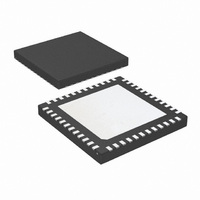LMK01000ISQX/NOPB National Semiconductor, LMK01000ISQX/NOPB Datasheet - Page 16

LMK01000ISQX/NOPB
Manufacturer Part Number
LMK01000ISQX/NOPB
Description
IC CLK BUFFER/DVDR/DISTR 48-LLP
Manufacturer
National Semiconductor
Type
Fanout Buffer (Distribution), Dividerr
Datasheet
1.LMK01010ISQENOPB.pdf
(22 pages)
Specifications of LMK01000ISQX/NOPB
Number Of Circuits
1
Ratio - Input:output
2:8
Differential - Input:output
Yes/Yes
Input
Clock
Output
LVDS, LVPECL
Frequency - Max
1.6GHz
Voltage - Supply
3.15 V ~ 3.45 V
Operating Temperature
-40°C ~ 85°C
Mounting Type
Surface Mount
Package / Case
48-LLP
Frequency-max
1.6GHz
For Use With
LMK01000EVAL - BOARD EVALUATION FOR LMK01000
Lead Free Status / RoHS Status
Lead free / RoHS Compliant
Other names
LMK01000ISQX
Available stocks
Company
Part Number
Manufacturer
Quantity
Price
Company:
Part Number:
LMK01000ISQX/NOPB
Manufacturer:
IR
Quantity:
23 000
www.national.com
3.3 THERMAL MANAGEMENT
Power consumption of the LMK01000 family device can be
high enough to require attention to thermal management. For
reliability and performance reasons the die temperature
should be limited to a maximum of 125 °C. That is, as an es-
timate, T
sumption times θ
The package of the device has an exposed pad that provides
the primary heat removal path as well as excellent electrical
grounding to the printed circuit board. To maximize the re-
moval of heat from the package a thermal land pattern in-
cluding multiple vias to a ground plane must be incorporated
on the PCB within the footprint of the package. The exposed
pad must be soldered down to ensure adequate heat con-
duction out of the package. A recommended land and via
pattern is shown in
LLP packages can be obtained at www.national.com.
To minimize junction temperature it is recommended that a
simple heat sink be built into the PCB (if the ground plane
layer is not exposed). This is done by including a copper area
of about 2 square inches on the opposite side of the PCB from
the device. This copper area may be plated or solder coated
to prevent corrosion but should not have conformal coating (if
possible), which could provide thermal insulation. The vias
shown in
per layers and to the ground layer. These vias act as “heat
pipes” to carry the thermal energy away from the device side
of the board to where it can be more effectively dissipated.
3.4 TERMINATION AND USE OF CLOCK OUTPUTS
When terminating clock drivers keep in mind these guidelines
for optimum phase noise and jitter performance:
•
•
•
It is possible to drive a non-LVPECL or non-LVDS receiver
with a LVDS or LVPECL driver as long as the above guide-
Transmission line theory should be followed for good
impedance matching to prevent reflections.
Clock drivers should be presented with the proper loads.
— LVDS drivers are current drivers and require a closed
— LVPECL drivers are open emitter and require a DC
Receivers should be presented with a signal biased to
their specified DC bias level (common mode voltage) for
proper operation. Some receivers have self-biasing inputs
that automatically bias to the proper voltage level. In this
case, the signal should normally be AC coupled.
FIGURE 2. Recommended Land and Via Pattern
current loop.
path to ground.
A
Figure 2
(ambient temperature) plus device power con-
JA
should connect these top and bottom cop-
should not exceed 125 °C.
Figure
2. More information on soldering
30042873
16
lines are followed. Check the datasheet of the receiver or
input being driven to determine the best termination and cou-
pling method to be sure the receiver is biased at the optimum
DC voltage (common mode voltage). For example, when driv-
ing the OSCin/OSCin* input of the LMK01000 family, OSCin/
OSCin* should be AC coupled because OSCin/ OSCin* bi-
ases the signal to the proper DC level, see
only slightly different from the AC coupled cases described
(See Section 3.4.2) because the DC blocking capacitors are
placed between the termination and the OSCin/OSCin* pins,
but the concept remains the same, which is the receiver (OS-
Cin/ OSCin*) set the input to the optimum DC bias voltage
(common mode voltage), not the driver.
3.4.1 Termination for DC Coupled Differential Operation
For DC coupled operation of an LVDS driver, terminate with
100 Ω as close as possible to the LVDS receiver as shown in
Figure
pling it is recommend to use LVDS receivers without fail-safe
or internal input bias such as National Semiconductor's
DS90LV110T. The LVDS driver will provide the DC bias level
for the LVDS receiver. For operation with LMK01000 family
LVDS drivers it is recommend to use AC coupling with LVDS
receivers that have an internal DC bias voltage. Some fail-
safe circuitry will present a DC bias (common mode voltage)
which will prevent the LVDS driver from working correctly.
This precaution does not apply to the LVPECL drivers.
For DC coupled operation of an LVPECL driver, terminate
with 50 Ω to Vcc - 2 V as shown in
terminate with a Thevenin equivalent circuit (120 Ω resistor
connected to Vcc and an 82 Ω resistor connected to ground
with the driver connected to the junction of the 120 Ω and 82
Ω resitors) as shown in
FIGURE 4. Differential LVPECL Operation, DC Coupling
FIGURE 3. Differential LVDS Operation, DC Coupling
3. To ensure proper LVDS operation when DC cou-
Figure 5
for Vcc = 3.3 V.
Figure
Figure
4. Alternatively
1. This is
30042820
30042821











